 Introduction
Introduction
In the world mainly dominated by slow cheap large capacity drives how does the small capacity expensive raptors keep up? Well with speed of course! The new Velciraptor from Western Digital is not only faster than its predecessor but also twice as large. Does the drive keep up with its claims? Does it even have a slot in the market now that SSDs are becoming more affordable? Is the price tag worth the performance gain? Read on and find out.
Specifications
While the specifications for the new drive look similar to its predecessor one of the key features of the new design is the 6Gb/s transfer rate. This means that in order to take full advantage of the burst rates one must connect the drive to a SATA III interface. Other enhancements over the old drive model include lower seek times and more importantly a doubled buffer size.
| Performance Specifications | Rotational Speed | 10,000 RPM (nominal) |
| Buffer Size | 32 MB | |
| Average Latency | 3.00 ms | |
| Load/unload Cycles | 600,000 minimum | |
| Seek Times | Read Seek Time | 3.6 ms (average) |
| Write Seek Time | 4.2 ms (average) | |
| Track-To-Track Seek | 0.4 ms (average) | |
| Transfer Rates | Buffer To Host (Serial ATA) | 6 Gb/s (Max) |
–~~~~~~~~~~~~–
Benchmarks
Testing Platform
- Chassis: LianLi PC-A77 Chassis
- Motherboard: ASUS P6T Deluxe
- Power Supply: Kingwin MACH 1 – 700W
- Processor: Intel Core i7 920 @ 2.66 GHz
- Ram: Corsair Dominator PC-12800 @ 1600 MHz
- SATA 3 Card: ASUS U3S6 PCI Express 4x
Tests
- HD Tune – Read
- SiSoft Sandra
- Crystal Disk Mark
HD Tune – Read
The Velociroaptor performed extremely well at max capacity. The max, min and average speeds of the drive were: 149.2, 88.3, and 124.6 respectively. The average access time was 6.99 ms and the burst rate for the drive was recorded at 259.0 MB/s. All this was done at 3.5% load on the CPU. When comparing these benchmarks with the ones to the raptor we reviewed a while back these were 122.6, 73.9, 100.6 MB/s respectively. The new drive yields an approximate 20 – 30 MB gain across the board over this old drive.
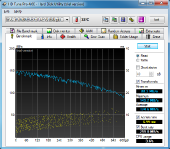 |
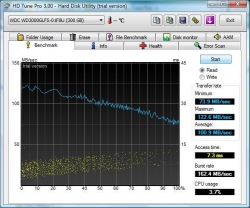 |
| Velociraptor 600 GB (new) | Velociraptor 300 GB (old) |
HD Tune – Write
The new Velociraptor did not come up short in the writing department either. The max, min, average values are 147.3, 87.2, and 122.3 MB/s respectively. The average access time for the drive while performing writing operations came out to an astounding 2.43 ms. The burst rate for the drive came in at 249.9 MB/s at a CPU load of 3.7%.
HD Tune – File Access
The HD Tune – File Access benchmark also demonstrated the new drive’s performance to be superior in all aspects to those of the old drive. As can be seen in the pictures below, the 8192 KB chunks of a 64 MB file access speeds for the old drive barely scratch 90 MB/s while the new drive performance reaches well over the 150 MB/s mark. Same performance gains are also evident. At the 4 KB mark the read speeds for the new drive are approximate 50 MB/s while the old drive hovers around 35 MB/s mark.
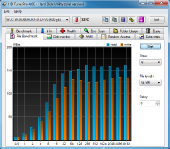 |
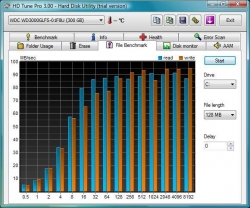 |
| Velociraptor 600 GB (new) | Velociraptor 300 GB (old) |
Crystal Disk Mark – 50 MB
While HD Tune benchmarks were surprising, these Crystal Disk Mark results were even more impressive. The new drive the speeds of the benchmark across almost all categories were improved. The sequential reads and write exhibited speeds of 176 and 143 MB/s speeds which translated to 78% and 40% gains respectively. Furthermore performance gains in the 512 K and 4K block sizes exhibited 90 -100 % improvement.
 |
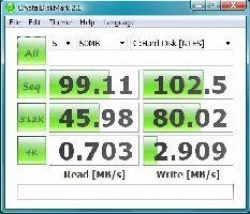 |
| Velociraptor 600 GB (new) | Velociraptor 300 GB (old) |
Crystal Disk Mark – 500 MB
In the 500 MB benchmark, the newer Velociraptor also proved to have significantly better results than its older counterpart. Sequential read and write demonstrated 65% and 54% performance gains. Similar results presented themselves in the 512K and 4K tests. 512 K test resulted in a 60 % read and a 48 % gains. The 4K block size test produced 53% read performance gains and 8% write gains.
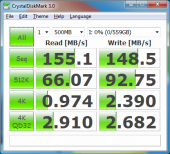 |
 |
| Velociraptor 600 GB (new) | Velociraptor 300 GB (old) |
Crystal Disk Mark – 1000 MB
The 1000 MB test produced slightly mixed results. While the sequential and 512 K produced results similar to the previous Crystal Disk Mark benchmarks with gains ranging from 30% – 40%. The interesting part, however, came at the 4K block size. The read performance at the 4K block size amounted to an approximate 30% gain, however, the write performance experienced a 7% loss.
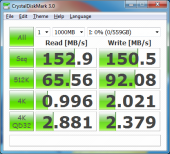 |
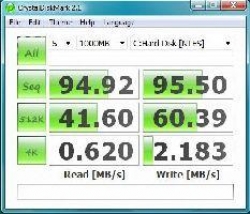 |
| Velociraptor 600 GB (new) | Velociraptor 300 GB (old) |
Crystal Disk Mark – 4000 MB
The most notable results of the 400o MB test were in the 4K region. Write speeds exceeded read speeds of the previous benchmarks by 100%. The write speeds of 4K block also exceed those of previous tests by 100%.
SiSoft Sandra – Physical Disk
SiSoft Sandra physical disk benchmark evaluates the read speeds across an entire drive and displays the average as the result. The benchmark also evaluates the seek times across the entire drive and outputs the average. The average read speed of the drive was reported to 124.854 MB/s with an average seek time of 7.12 ms.
–~~~~~~~~~~~~–
Enhancements
Here at Techwarelabs we are all about getting the most bang for the buck. This is why I will be discussing the results obtained by short stroking the drive. Using the same method as in the article: Modifying the Seagate 1.5TB Hard Drive: Unleash the Hidden Performance where we short stroke the drive to 450 GB and 300 GB. Below are the results in the same benchmarks as were run on the original capacity.
HD Tune – Read
The read speeds between the two sizes were similar. Better performance was exhibited in the 300 GB by approximately 8 MB/s for average speed, and 20 MB/s minimum speed. This leads to an overall performance gain of approximately 28 MB/s average, and 40 MB/s min from the original size.
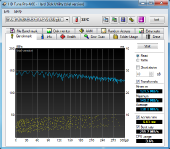 |
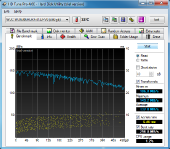 |
| Velociraptor Short Stroke 300 GB | Velociraptor Short Stroke 450 GB |
HD Tune – Write
There were also significant improvements in the Write benchmark. Velociraptor at 300 GB performed 135.8 MB/s average, and 118 MB/s minimum. The overall improvement from the original size was 30 MB/s minimum and 15 MB/s average.
 |
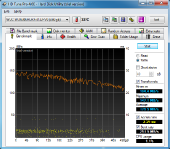 |
| Velociraptor Short Stroke 300 GB | Velociraptor Short Stroke 450 GB |
HD Tune – File Access
The modification to the hard drive would not be evident in this test. This is mainly due to file size. Here the tests are run using the best scenario, meaning that the 64 MB file would be written on the very edge of the disk (where the drive the drive is the fastest). This is demonstrated in the images below, where the benchmarks yielded very similar results despite one capacity being 450 GB and the other 300 GB.
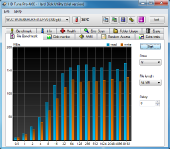 |
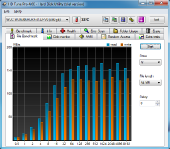 |
| Velociraptor Short Stroke 300 GB | Velociraptor Short Stroke 450 GB |
Crystal Disk Mark – 50 MB
The 50 MB file transfer mostly takes advantage of the burst speed of the hard drive (about 250 MB/s for this drive). The transfer rates for both modded capacities were significantly better than those of the full capacity. Sequential read reported a 22 MB/s gain while the sequential write reported a 12 MB/s loss for both capacities when compared to the original capacity.
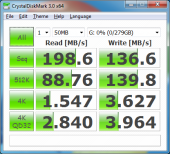 |
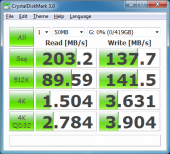 |
| Velociraptor Short Stroke 300 GB | Velociraptor Short Stroke 450 GB |
Crystal Disk Mark – 500 MB – 4000 MB
500MB through 4000 MB showed similar results throughout all the tests. All of the results produced slightly better results in sequential reads that the original capacity test while all other results produced approximately 1 – 2 MB/s lower results than those of the original capacity. This can be mainly justified due to the fact that this test runs in a limited space provided by original parameters. This means that the advantage gained by short stroking the drive would not be as evident.
| Crystal Disk Mark – 500 MB | |
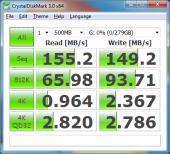 |
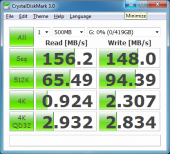 |
| Velociraptor Short Stroke 300 GB | Velociraptor Short Stroke 450 GB |
| Crystal Disk Mark – 1000 MB | |
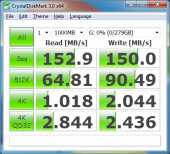 |
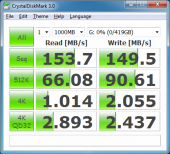 |
| Velociraptor Short Stroke 300 GB | Velociraptor Short Stroke 450 GB |
| Crystal Disk Mark – 4000 MB | |
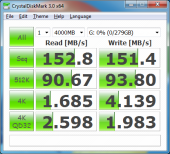 |
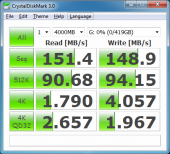 |
| Velociraptor Short Stroke 300 GB | Velociraptor Short Stroke 450 GB |
SiSoft Sandra – Physical Disk
Since SiSoft Sandra tests read speeds across the entire drive this test would take advantage of the short stroking. The results of this test corroborate those produced in HD Tune. The drive performed a 13 MB/s (average) better in the 300 GB test than the test using original capacity, and 6 MB/s than the test using 450 GB. The performance increases are also evident in the seek times. Velociraptor short stroked to 300 GB had faster seek times than both 450 GB and original capacity by 1.6 ms and 0.9 ms respectively.
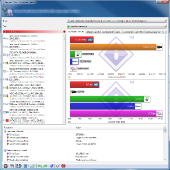 |
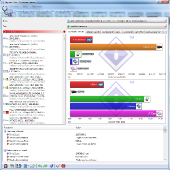 |
| Velociraptor Short Stroke 300 GB | Velociraptor Short Stroke 450 GB |
–~~~~~~~~~~~~–
Conclusion
After taking a look at all these benchmarks we come to a single question: Is the hefty price tag of $260 really worth the gains? This depends on what exactly you are looking for. SSDs will offer better performance,but the cheapest drive close to this capacity I see on newegg goes for $1319 at 512GB, which is nowhere near $260. Western Digital’s Velociraptor offers a sweet spot for those looking for performance but still need the space. And thus the simple answer to the question, is yes. The Velociraptor fills the void for relatively cheap performance/storage ratio and blows away its predecessor along with any other possible competition form the hard drive market.

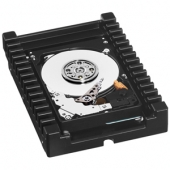
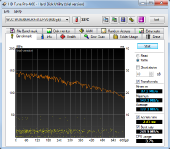
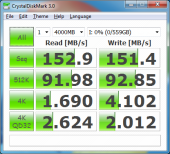
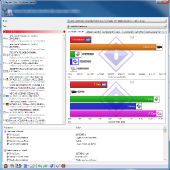

[…] PC-Q11 Mini-ITXInsideHW takes a look at the ViewSonic VX2739wm: Maximum HDTechwareLabs reviews the Western Digital – Velociraptor 600 GB Hard DriveTo finish us off, XSReviews tests out the Mushkin Blackline PC3-12800Share and Enjoy:Tags: Au-Ja, […]
[…] WD Scorpio Black 500GB Notebook Hard Drive Review @ Legit Reviews Western Digital – Velociraptor 600 GB Hard Drive @ TechwareLabs QNAP TS-859U-RP 8-Drive Rackmount NAS @ TweakTown OCZ Enyo USB 3.0 SSD Review @ […]